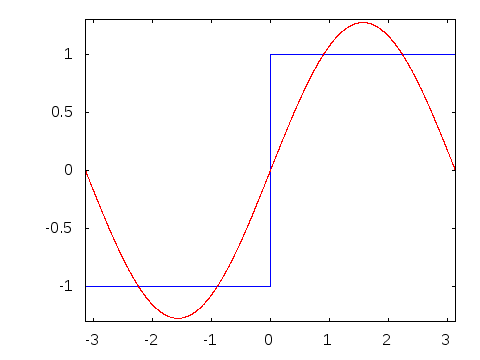我们首先考虑 **三角多项式**。 这些函数是不同正弦和余弦函数的总和。 例如

是一个三角多项式。 一般来说,三角多项式具有以下形式
![{\displaystyle A_{0}+\sum _{n=1}^{N}{\bigl [}A_{n}\cos(nx)+B_{n}\sin(nx){\bigr ]}}](https://wikimedia.org/api/rest_v1/media/math/render/svg/49197772eeee5836e2d8ff69e3a5bd8146db57bf)
实际上,这里潜在的想法与普通多项式没什么不同。 我们正在形成对我们熟知的函数的线性组合。 使用普通多项式,函数是  ,其中
,其中  。 这里的函数是
。 这里的函数是  或
或  ,其中
,其中 
|
实例
我们可以而且将会定义三角多项式的次数,并讨论它们的各种性质,但在我们深入研究之前,注意到哪些函数可以写成三角多项式可能很有趣。 例如,考虑

乍一看它不像三角多项式,但如果我们使用角和公式来计算  ,我们会发现它是 ,我们会发现它是

|
|
练习:另一种方法?
![{\displaystyle \sum _{n=0}^{N}{\bigl [}A_{n}\cos(nx)+B_{n}\sin(nx){\bigr ]}}](https://wikimedia.org/api/rest_v1/media/math/render/svg/20a908bd68bb0f6c553633d3a11acc7cf55cac8f)
看看上面三角多项式的公式。 它是否包含相同的函数?
|
|
练习:三角多项式

作为关于  的三角多项式 的三角多项式
|
除了角的和公式,我们还有另一个非常有用的工具。在许多令人惊叹的三角函数属性中, 和
和  是所谓的正交性关系。这些是关于积分的以下结果:
是所谓的正交性关系。这些是关于积分的以下结果:

类似地,


待办事项:使用对称性绘制图形来展示非正式论证,以说明为什么这样。
例如,以我们开始时用到的函数为例,  ,我们可以计算
,我们可以计算

注意最后一行遵循我们上面计算的积分。这意味着我们可以使用积分来确定三角多项式的系数。这是一个有趣的想法,因为并非所有三角多项式乍一看都是三角多项式。问题变成了我们如何知道什么时候停止计算三角多项式的系数?我们如何知道我们是否找到了所有系数?一个答案可能是比较图形。我们首先证明,当我们知道要走多远时,这个想法可以用在这种情况中,例如让

然后数值计算  和
和  的积分。我们可以从图中看到我们何时计算了所有系数,如下面的动画所示。
的积分。我们可以从图中看到我们何时计算了所有系数,如下面的动画所示。

让我们尝试另一个我们不知道三角多项式阶数的例子。函数  可以写成三角多项式,我们积分求系数并通过查看图形来判断何时完成的过程可以使用,下面是动画演示。
可以写成三角多项式,我们积分求系数并通过查看图形来判断何时完成的过程可以使用,下面是动画演示。

注意,对于这个特定函数,要决定何时结束需要相当长的时间。事实证明,我们必须一直到 **N=48** 才能找到所有系数。这看起来可能是个问题,特别是如果我们不小心从一个不是三角多项式的函数开始。
为了看看会发生什么,让我们假设我们从一个方波开始,也就是说,我们让

并且  被定义为周期为
被定义为周期为  的周期函数,即我们定义
的周期函数,即我们定义  。如果我们在
。如果我们在  上使用我们的过程,那么我们很快就会发现它似乎永远不会停止,如动画所示
上使用我们的过程,那么我们很快就会发现它似乎永远不会停止,如动画所示

此动画显示,当我们在三角多项式中增加项数时,我们永远无法完全达到原始函数。另一方面,我们越来越接近,尤其是在远离 的地方。
的地方。
有了这样的动机,我们可以提出一个大胆的问题:如果我们让项数趋于无穷,三角多项式是否会收敛到方波?这就是傅里叶级数研究的起点。


![{\displaystyle A_{0}+\sum _{n=1}^{N}{\bigl [}A_{n}\cos(nx)+B_{n}\sin(nx){\bigr ]}}](https://wikimedia.org/api/rest_v1/media/math/render/svg/49197772eeee5836e2d8ff69e3a5bd8146db57bf)







![{\displaystyle \sum _{n=0}^{N}{\bigl [}A_{n}\cos(nx)+B_{n}\sin(nx){\bigr ]}}](https://wikimedia.org/api/rest_v1/media/math/render/svg/20a908bd68bb0f6c553633d3a11acc7cf55cac8f)






















